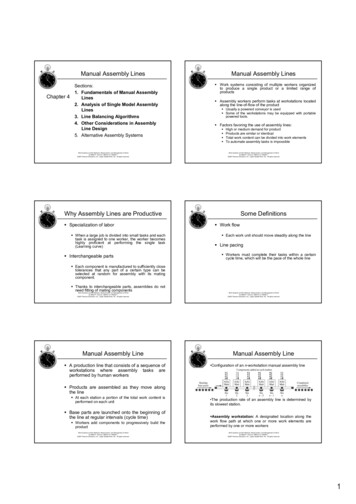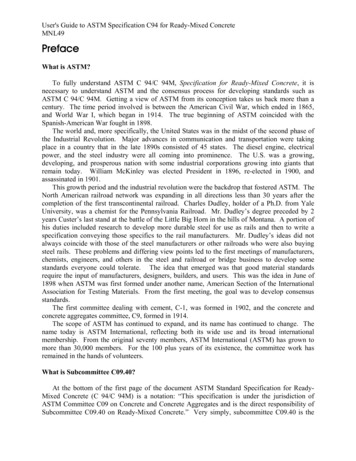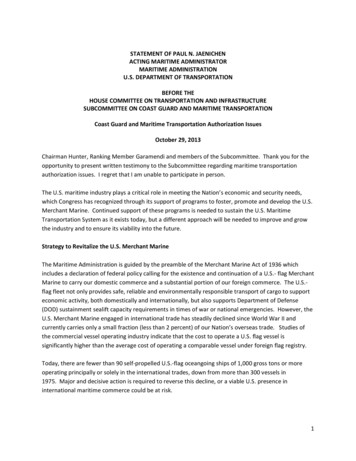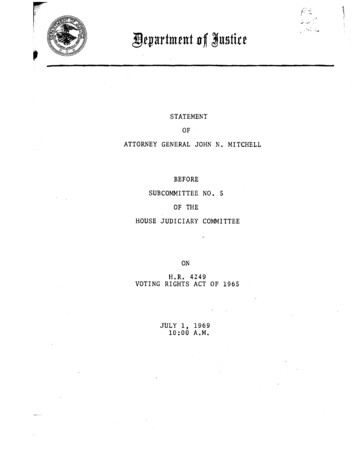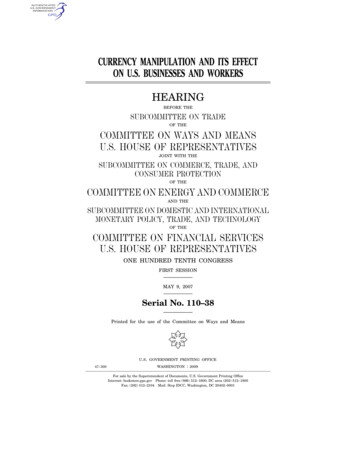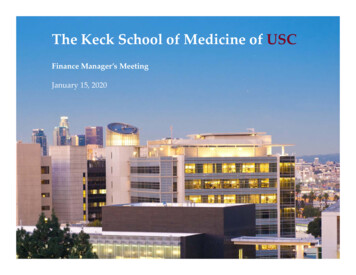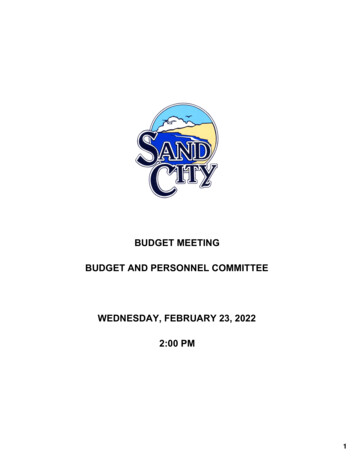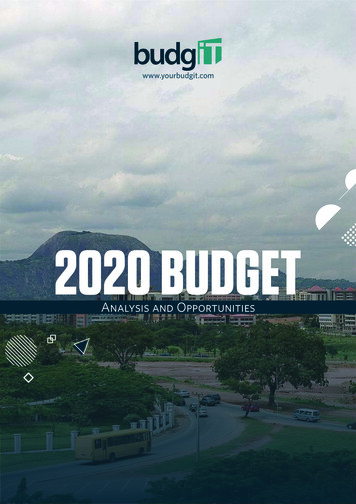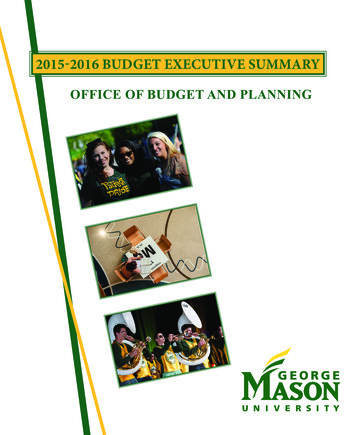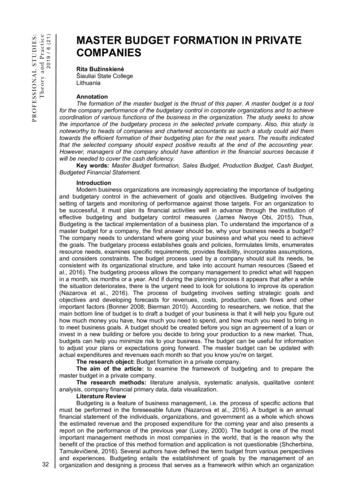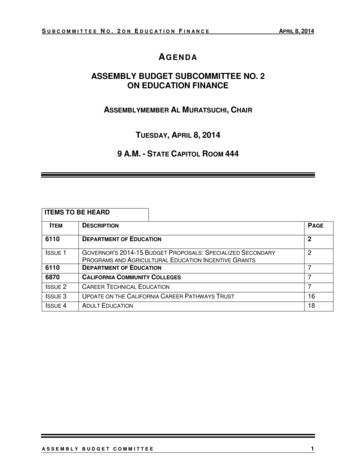
Transcription
SUBCOMMITTEE NO. 2ON EDUCATION FINANCEAPRIL 8, 2014AGENDAASSEMBLY BUDGET SUBCOMMITTEE NO. 2ON EDUCATION FINANCEASSEMBLYMEMBER AL MURATSUCHI, CHAIRTUESDAY, APRIL 8, 20149 A.M. - STATE CAPITOL ROOM 444ITEMS TO BE HEARDITEMDESCRIPTIONPAGE6110DEPARTMENT OF EDUCATION2ISSUE 1GOVERNOR'S 2014-15 BUDGET PROPOSALS: SPECIALIZED SECONDARYPROGRAMS AND AGRICULTURAL EDUCATION INCENTIVE GRANTSDEPARTMENT OF EDUCATIONCALIFORNIA COMMUNITY COLLEGESCAREER TECHNICAL EDUCATIONUPDATE ON THE CALIFORNIA CAREER PATHWAYS TRUSTADULT EDUCATION261106870ISSUE 2ISSUE 3ISSUE 4ASSEMBLY BUDGET COMMITTEE77716181
SUBCOMMITTEE NO. 2ON EDUCATION FINANCEAPRIL 8, 2014ITEMS TO BE HEARD6110 DEPARTMENT OF EDUCATIONISSUE 1: GOVERNOR'S 2014-15 BUDGET PROPOSALS: SPECIALIZEDSECONDARY PROGRAMS AND AGRICULTURAL EDUCATION INCENTIVEGRANTSThe Subcommittee will consider the Governor's budget proposal to consolidate two CTEcategorical programs – Specialized Secondary Programs and Agricultural Education IncentiveGrants – into the Local Control Funding Formula.PANELISTS: Ed Hanson, Department of Finance Natasha Collins, Legislative Analyst's Office Monique Ramos, Department of EducationBACKGROUNDThe 2013-14 budget consolidated approximately two-thirds of all categorical programs with thediscretionary revenue limit funding to create the more simplified Local Control Funding Formula(LCFF). However, 13 categorical programs continue to be funded outside of the LCFF. Theseprograms include: Adults in Correctional FacilitiesAfter School Education and SafetyAgricultural Education Incentive GrantsAmerican Indian Education Centers and Early Childhood Education ProgramAssessmentsChild NutritionFoster Youth ServicesMandates Block GrantPartnership AcademiesQuality Education Improvement ActSpecial EducationSpecialized Secondary ProgramsState PreschoolThese 13 categorical programs were left outside of the LCFF for various reasons. Someprograms were maintained outside the formula in order to comply with federal requirements,while others remain a high state priority.Governor's 2014-15 BudgetThe Governor's Budget proposes to eliminate two additional categorical programs – SpecializedSecondary Programs (SSPs) and Agricultural Education Incentive Grants.Under theGovernor’s proposal, school districts that received this categorical funding in 2013-14 wouldASSEMBLY BUDGET COMMITTEE2
SUBCOMMITTEE NO. 2ON EDUCATION FINANCEAPRIL 8, 2014continue to receive funding, however, those funds would count towards their LCFF targetsbeginning in 2014-15 and the use of the funds would become entirely discretionary.Specialized Secondary Programs (SSPs)SSPs were created in 1984 in order to provide students with advanced instruction and trainingin specialized fields, such as technology, science and the performing arts. SSPs providefunding for two purposes: competitive grants provided for start-up costs and ongoing funding fortwo specialized high schools. The intent of the Legislature in establishing SSPs was to benefitthe state economy by providing opportunities to talented pupils to obtain enhanced learningopportunities in specialized fields in areas of the state where these industries are located. TheLegislature also recognized that SSPs will allow for faculty to develop model curriculum, in turn,benefiting schools throughout the state.In 2013-14, the state provided 4.9 million in Proposition 98 General Fund for SSP. Themajority of this funding is used to award competitive grants for high schools to plan and institutespecialized programs. Since the inception of SSP, the CDE has awarded over 200 competitivegrants for specialized programs throughout the state. SSP competitive grants are distributedover four years. School districts can apply for a one-year planning grant followed by a threeyear implementation grant. The funds can be used for equipment, supplies, and staffcompensation, including additional time for developing curriculum. In 2013-14 CDE awarded 67SSP competitive grants, totaling 3.4 million. These grant recipients are shown below.Specialized Secondary Programs2013-14 Grants AwardedCountyLocal Educational AgencyAlamedaAlamedaButteButteContra CostaContra CostaContra eLos AngelesLos AngelesLos AngelesLos AngelesLos AngelesLos AngelesLos AngelesLos AngelesLos AngelesLos AngelesLos AngelesLos AngelesLos AngelesLos AngelesBerkeley Unified School DistrictOakland Unified School DistrictChico Unified School DistrictChico Unified School DistrictJohn Swett Unified School DistrictLiberty Union High School DistrictWest Contra Costa Unified School DistrictFresno Unified School DistrictKings Canyon Joint Unified School DistrictParlier Unified School DistrictNorthern Humboldt Union High School DistrictCalexico Unified School DistrictTehachapi Unified School DistrictKonocti Unified School DistrictMiddletown Unified School DistrictCentinela Valley Union High School DistrictGlendale Unified School DistrictLas Virgenes Unified School DistrictLong Beach Unified School DistrictLong Beach Unified School DistrictLos Angeles Unified School DistrictLos Angeles Unified School DistrictLos Angeles Unified School DistrictLos Angeles Unified School DistrictLos Angeles Unified School DistrictLos Angeles Unified School DistrictLos Angeles Unified School DistrictLos Angeles Unified School DistrictLos Angeles Unified School DistrictASSEMBLY BUDGET COMMITTEEGrantAmount 50,000 50,000 50,000 50,000 50,000 50,000 50,000 50,000 50,000 50,000 50,000 50,000 50,000 50,000 50,000 50,000 50,000 50,000 50,000 50,000 50,000 50,000 50,000 50,000 50,000 50,000 50,000 50,000 50,0003
SUBCOMMITTEE NO. 2ON EDUCATION FINANCELos AngelesLos ramentoSacramentoSacramentoSan BernardinoSan BernardinoSan BernardinoSan BernardinoSan DiegoSan DiegoSan DiegoSan JoaquinSan JoaquinSan MateoSanta BarbaraSanta ClaraSanta ClaraSanta otal:Pasadena Unified School DistrictPasadena Unified School DistrictHilmar Unified School DistrictSoledad Unified School DistrictNevada Joint Union High School DistrictAnaheim Union High School DistrictHuntington Beach Union High School DistrictIrvine Unified School DistrictOrange County Department of EducationPlacentia-Yorba Linda Unified School DistrictPlacentia-Yorba Linda Unified School DistrictWestern Placer Unified School DistrictRiverside County Office of EducationRiverside Unified School DistrictElk Grove Unified School DistrictFolsom-Cordova Unified School DistrictFolsom-Cordova Unified School DistrictTwin Rivers Unified School DistrictChino Valley Unified School DistrictSan Bernardino City Unified School DistrictApple Valley Unified School DistrictApple Valley Unified School DistrictCoronado Unified School DistrictGrossmont Union High School DistrictValley Center-Pauma Unified School DistrictManteca Unified School DistrictManteca Unified School DistrictCabrillo Unified School DistrictSanta Barbara Unified School DistrictEast Side Union High School DistrictEast Side Union High School DistrictEast Side Union High School DistrictAnderson Union High School DistrictSonoma Valley Unified School DistrictWindsor Unified School DistrictPorterville Unified School DistrictTulare Joint Union High School DistrictSimi Valley Unified School DistrictVentura County Office of EducationAPRIL 8, 2014 50,000 50,000 31,000 50,000 50,000 50,000 50,000 50,000 50,000 50,000 50,000 50,000 50,000 50,000 50,000 50,000 20,000 50,000 50,000 50,000 50,000 50,000 50,000 50,000 50,000 50,000 50,000 50,000 50,000 50,000 50,000 50,000 50,000 50,000 50,000 50,000 50,000 50,000 50,000 3,351,000Source: California Department of EducationIn addition to competitive grants, SSP provides 1.5 million in ongoing funding for two highschools that have partnered with the California State University (CSU) system in offeringspecialized programs. These high schools include the RFK Community Schools-Los AngelesHigh School of the Arts within the Los Angeles County Office of Education (affiliated with CSULos Angeles) and the California Academy of Mathematics and Science in the Long BeachUnified School District (affiliated with CSU Dominguez Hills). These two schools each receive 750,000 per year in ongoing SSP funding, in addition to their LCFF funding. The SSP fundsare primarily used for specialized instructors, who are not required to be credentialed.According to data collected by the CDE from 2012-13, the RFK Community Schools-LosAngeles High School of the Arts received a growth API score of 708 and a graduation rate of61.7 percent. The California Academy of Mathematics and Science received a growth APIscore of 961 and a graduation rate of 98.7 percent. This is compared to the statewide averagegrowth API of 757 and graduation rate of 78.7 percent.ASSEMBLY BUDGET COMMITTEE4
SUBCOMMITTEE NO. 2ON EDUCATION FINANCEAPRIL 8, 2014Agricultural Education Incentive GrantsAgricultural Education Incentive Grants provide ongoing grant funding to high schools withapproved agricultural programs. The purpose of the grant program is to maintain a high-qualityagricultural vocational program in California's high schools in order to ensure a trained andskilled workforce within the agricultural sector. Approved agricultural programs include thefollowing components: classroom instruction, leadership activities, and a project-basedoccupational experience.In 2013-14 CDE has granted 303 Agricultural Education Incentive Grants to 222 school districts,totaling 4.1 million. The grant funding can be used for non-salaried purposes, such asagricultural supplies and equipment, as well as field trips and conferences. Grant recipientsalso must provide matching funds. In order to receive ongoing funding, grant recipients areevaluated annually on the quality of their program, which includes on-site reviews and technicalassistance.Future Farmers of America. An integral part of each school's agricultural education program isthe California Association of Future Farmers of America (FFA). FFA is a student organizationfor grades 9-12 that coordinates and administers leadership activities related to agriculturaleducation. The FFA was established in 1928 and is administered through the AgriculturalEducation Unit of the CDE. The mission of the FFA is to make a positive difference in the livesof students by developing their potential for premier leadership, personal growth and careersuccess through agricultural education. There are approximately 70,523 FFA members inCalifornia, within 305 high schools.LAO RecommendationThe LAO recommends the Legislature approve the Governor's budget proposal to consolidateSSP and Agricultural Education Grants into the LCFF. The LAO argues that districts wouldhave the option of using these funds exactly as they do now, or they would have the flexibility touse the funds in a different way to meet students' needs. The LAO believes this approach isconsistent with the principles of the LCFF. The LAO recommends adopting an overall approachto CTE that relies on student outcomes, instead of specific programmatic requirements.STAFF COMMENTS/QUESTIONS:Specialized Secondary ProgramsThe purpose of SSPs is to encourage innovation and allow for instructors to develop modelcurriculum in specialized subject areas. The SSP competitive grant has provided the necessaryseed funding for districts to develop high quality programs in specialized fields. Additionally, theSSP funded high schools have served as a model for other schools in providing innovativeprograms in partnership with their local institutions of higher education. Without this dedicatedfunding, it is unknown whether these unique programs would continue.Agricultural Education Incentive GrantsCalifornia is the leading agricultural producing state in the nation. According to the CaliforniaDepartment of Food and Agriculture, California ranked first in the nation in agricultural cashreceipts in 2012. California produces more than 350 agricultural commodities, representing11 percent of the U.S. total. California’s leading crops include fruits, nuts and vegetables. Overa third of the country’s vegetables and nearly two-thirds of the country’s fruits and nuts areproduced in California.ASSEMBLY BUDGET COMMITTEE5
SUBCOMMITTEE NO. 2ON EDUCATION RIL 8, 2014Top 5 Agricultural States in Cash Receipts (2012)RankTotal Value (In Billions)1 44.72 31.93 24.44 22.75 20.5Source: California Department of Food and AgricultureGiven the importance of agriculture on California's economy, it is essential that California'seducation system adequately prepares students to enter this field. The Agricultural EducationIncentive Grant is a small investment to incentivize schools to offer quality agricultural educationprograms. These agricultural education programs provide the necessary hands-on training tobetter prepare students for a career in agriculture and will help ensure that California remainsthe leading agricultural producer in the nation.Suggested Questions: Why is the Governor proposing to consolidate SSP and Agricultural Education IncentiveGrants into the LCFF after the Legislature deemed them a high statewide priority just ayear ago? Why is the Governor proposing to eliminate these two CTE programs, but notPartnership Academies? How has SSP inspired innovation in California's high schools? Given that California is the leading agricultural state in the nation, should the Legislatureprovide local school districts with discretion in offering agricultural education? Whatincentives would districts have in maintaining agricultural education? Without dedicated funding for SSPs and Agricultural Education Incentive Grants, willschools maintain these programs? What are the potential impacts on California'seconomy and workforce if districts choose to direct this funding elsewhere? Specifically,how will this impact industry sectors such as agriculture, technology and the arts?ASSEMBLY BUDGET COMMITTEE6
SUBCOMMITTEE NO. 2ON EDUCATION FINANCEAPRIL 8, 20146110 DEPARTMENT OF EDUCATION6870 CALIFORNIA COMMUNITY COLLEGESISSUE 2: CAREER TECHNICAL EDUCAITONThe Subcommittee will discuss the importance of career technical education (CTE) and thecurrent programs that exist. The Subcommittee will also consider options for increasingregional collaboration with California's high schools, community colleges and industry leaders indelivering CTE throughout the state.PANEL 1: Paul Steenhausen, Legislative Analyst's Office Monique Ramos, Department of Education Van Ton-Quinlivan, Vice Chancellor of Workforce and Economic Development, CommunityCollege Chancellor's Office Chris Ferguson, Department of FinancePANEL 2: Valerie Vuicich, ROP/CTE Administrator, Fresno County Office of Education Dr. Donald Stabler, Deputy Superintendent, Torrance Unified School District Jeff Cummings, Executive Dean of Academic Affairs and Career and Technical Education,College of the Redwoods Luis Barrera Castañòn, Manager of Education Policy and Programs, Los Angeles AreaChamber of CommerceBACKGROUNDCareer technical education (CTE) is coursework in 15 industry sectors that provides studentswith hands-on learning to better prepare them for higher education and a career. Traditionally,CTE has been thought of as an alternative to college preparatory classes. However, the statehas increasingly encouraged the career pathways model, which offers a sequence of CTEclasses aligned to a specific industry sector that provides both college and career options uponcompletion of high school. The purpose of CTE is to both improve student outcomes and betterprepare students to fill industry needs.High School CTE ProgramsAccording to the California Department of Education (CDE), 850,227 high school studentsenrolled in CTE in 2011-12, the most recent data available. The CDE allows for CTEcoursework in 15 industry sectors. Specifically, these industry sectors include: AgricultureASSEMBLY BUDGET COMMITTEE7
SUBCOMMITTEE NO. 2ON EDUCATION FINANCE APRIL 8, 2014Arts, Media, and EntertainmentBuilding Trades and ConstructionBusiness and FinanceChild Development and Family ServicesEnergy and UtilitiesEngineering and DesignFashion and Interior DesignHealth Science and Medical TechnologyHospitality, Tourism, and RecreationInformation TechnologyManufacturing and Product DevelopmentMarketing, Sales, and ServicesPublic ServicesTransportationHigh school CTE programs are funded in a variety of ways, including categorical programs, onetime competitive grants, foundation contributions, federal funding, and general purpose funding.The chart below outlines the various CTE programs that serve California's high school students.California's High School Career Technical Education Programs(2013-14, Unless Otherwise Centers andPrograms (ROCP)DescriptionRegionally focused CTE offered during the school day, after school,and in the evening at high schools and regional centers.Primarily serves high school students ages 16 through 18.Funding(InMillions) 384.0a250.0Career PathwaysTrustOne–time competitive grants intended to improve linkagesbetween CTE programs at schools, community colleges, and localbusinesses. Authorizes several types of activities, such ascreating new CTE programs and curriculum. These funds areavailable for expenditure through 2015–16.CTE PathwaysInitiativeFunding intended to improve linkages between CTE programs atschools, community colleges, universities, and local businesses.This program sunsets at the end of 2014–15. Of these funds, 8.2 million supports California Partnership Academies and 5.2million supports Linked Learning (both reflected below).48.0CaliforniaPartnershipAcademiesSmall learning cohorts that integrate a career theme withacademic education in grades 10 through 12. Considered a formof Linked Learning (see below).29.6Linked LearningOne–time funding to support small, career–themed learningcohorts within comprehensive high schools that tie academiccoursework to technical content and work–based ve grants that provide seed money to pilot programs thatprepare students for college and careers in specialized fields( 3.4 million). Funding also supports two high schoolsspecializing in math, science, and the arts ( 1.5 million).4.9Agricultural CTEIncentiveProgramOngoing funding that can be used for the purchase of nonsalaryitems for agricultural education. Funds are commonly used topurchase equipment and pay for student field trips. Districts arerequired to provide matching funds.4.1Federally Funded ProgramsASSEMBLY BUDGET COMMITTEE8
SUBCOMMITTEE NO. 2ON EDUCATION FINANCEAPRIL 8, 2014Carl D. PerkinsOngoing funding that can be used for a number of CTE purposes,including curriculum and professional development and theacquisition of equipment and supplies for the classroom. Of thesemonies, 85 percent directly funds local CTE programs and theother 15 percent supports statewide administration andleadership activities. 56.3Youth CareerConnect GrantOne–time competitive grants available for the 2014–15 schoolyear that are intended to improve career options for high schoolstudents by facilitating partnerships with businesses, highschools, and higher education. Grant recipients are required toprovide a 25 percent match.12.0caDue to categorical flexibility allowed between 2008–09 and 2012–13, this amount is likely higher than the actual amount spentby providers on ROCP. In 2013–14 and 2014–15, providers must spend on ROCP at least as much as in 2012–13.bIn addition, since 2008, the James Irvine Foundation has contributed more than 100 million to Linked Learning.cAssumes California receives an amount proportional to its population (12 percent). Total federal appropriation is 100 million.Source: Legislative Analyst's OfficeRegional Occupational Centers and ProgramsThe state's largest high school CTE program is the Regional Occupational Centers andPrograms (ROCPs), which provides regionally focused CTE in a variety of disciplines. ROCPsoffer high school students (16 years of age and older) and adult students, with career andtechnical education so students can (1) enter the workforce with the necessary skills to besuccessful, (2) pursue advanced training in postsecondary education, or (3) upgrade existingskills and knowledge. ROCPs can be operated through county offices of education, schooldistricts, or a consortium of districts through a Joint Powers Authority (JPA). Students receivetraining at a variety of venues, such as regular classrooms on high school campuses,businesses and industry facilities or regional centers. ROCP courses can be offered during theschool day, after school and in the evenings. Some ROCPs also offer courses for adultstudents, typically for a fee.According to the California Department of Education (CDE), there are approximately 74 ROCPsin California, serving approximately 470,000 students annually. The CDE argues that, ROCPshelp to close the achievement gap by motivating students to learn both academic andoccupational skills for future success in a career of the student's choosing. A 2007 longitudinalstudy done by Douglas E. Mitchell of the University of California, Riverside found that studentparticipation in ROCPs resulted in improved grade point averages, increased post-secondaryeducation enrollment and higher wages later on, when compared to similar students. This studyalso found that students preferred ROCP courses over other subjects and even questioned thevalue and relevance of other high school courses.Prior to the 2008-09 fiscal year, the state provided dedicated funding for ROCPs through acategorical program totaling approximately 486 million. In 2008-09, due to budget cuts, theLegislature provided LEAs with "categorical flexibility" for many categorical programs (includingROCPs), meaning that LEAs could use the categorical funding for any educational purpose. Inaddition to categorical flexibility, many programs were cut by approximately 20 percent in 200910. During this time, LEAs received approximately 384 million in ROCP funding, but were notrequired to use this funding on ROCPs.ASSEMBLY BUDGET COMMITTEE9
SUBCOMMITTEE NO. 2ON EDUCATION FINANCEAPRIL 8, 2014ROCPs Under LCFF.The 2013-14 budget consolidated most categorical programs into the base funding within theLocal Control Funding Formula (LCFF), including funding for ROCPs. In order to ensureROCPs continued to operate, the 2013-14 budget also required LEAs that operated ROCPs in2012-13 to continue to spend the same amount of funding on ROCPs in 2013-14 and 2014-15.However, after the 2014-15 school year, LEAs are not required to offer CTE and can spend thisROCP funding on any purpose.CTE Pathways InitiativeSB 70 (Scott), Chapter 352, Statutes of 2005, established the CTE Pathways Initiative, whichdirected the Board of Governors of the California Community Colleges to work with the CDE toimprove linkages and career-technical education pathways between high schools andcommunity colleges in order to create opportunities for students in both education systems.This bill allocated 20 million from the Community College reversion account to be specificallyused for improving CTE at both the community college and secondary level. Subsequentlegislation extended funding for this program until the 2014-15 fiscal year.The CTE Pathways Initiative has helped build 5,792 partnerships, developed over 1,000courses, provided trainings or externships to 36,000 staff at high schools and communitycolleges, and served approximately 750,000 students. In 2013-14, the state allocated 48 million Proposition 98 General Fund for the CTE Pathways Initiative, includingapproximately 15 million to the CDE and 33 million to be distributed to community collegeschool district partnerships. The Community College Chancellor’s office is required to work withCDE annually to develop a spending plan for these funds.California Partnership AcademiesThe California Partnership Academies (CPAs) were created through legislation in 1984 in orderto encourage the use of career focused academies in California's high schools. The careeracademy model integrates core subject areas and CTE, aligned to the academy's career theme.These career themes can be in any of the 15 industry sectors approved by the CDE. CPAs arerequired to partner with local employers, who help to provide internships and other opportunitiesfor students to gain hands-on experience. Employers also benefit by having a moreexperienced and knowledgeable workforce upon graduation. Each CPA is required to providematching funds from the host school district and their employer partner(s) equal to the CPAgrant amount from the state. By law, at least 50 percent of the students entering the CPAprogram must be considered "at risk" of dropping out of school. At risk students must meetcertain criteria, such as low test scores, poor attendance, and being economicallydisadvantaged, among other indicators.According to data collected by the CDE in 2009-10, students enrolled in CPAs performed aboveaverage on statewide tests and were more likely to graduate high school. Data shows that CPAtenth graders scored higher on the California High School Exit Exam (CAHSEE) than thestatewide average. Specifically, 82 percent of CPA students passed the English language artssection, compared with 81 percent statewide. On the mathematics portion of the exam, 83percent of CPA students passed, compared to 81 percent statewide. With respect to graduationrates, 95 percent of academy seniors graduated at the end of the 2009-10 year, compared with85 percent statewide.Currently, there are 450 CPAs in California's high schools, which receive funding through theCPA categorical program or the CTE Pathways Initiative. The state provides 29.6 million inCPA categorical funding. Although many other categorical programs were consolidated into theLCFF in 2013-14, CPAs were maintained outside of the LCFF.ASSEMBLY BUDGET COMMITTEE10
SUBCOMMITTEE NO. 2ON EDUCATION FINANCEAPRIL 8, 2014Linked Learning ProgramsLinked Learning programs, which include CPAs, use coursework, technical training, and workbased learning to provide real connections between high school and a career. AB 790(Furutani), Chapter 616, Statutes of 2011, established the Linked Learning Pilot Program to beadministered by CDE for the purposes of implementing districtwide Linked Learning pathways(referred to as "multiple pathways" prior to this legislation). This bill was in response to a reportreleased by CDE in 2010 that made recommendations for improving and expanding LinkedLearning in California's high schools.Funding for Linked Learning programs is provided through a combination of state and privatefunds. The state originally did not provide funding for AB 790. However, in October 2013, onetime state funding of 5.2 million was directed to the Linked Learning pilot sites from the CTEPathways Initiative funding. In addition to state funding, the James Irvine Foundation hasindicated that they have dedicated 100 million for Linked Learning programs since 2008.Federally Funded CTE ProgramsThe Carl D. Perkins Career Technical Education program provides 113 million in ongoingfederal funding for CTE programs, with half going to the K-12 system and half going tocommunity colleges. Of these funds, 85 percent goes directly to LEAs and community collegesto be used for CTE purposes, including curriculum, professional development, and purchasingequipment and supplies. The remaining 15 percent is provided to the CDE and the CommunityCollege Chancellor's Office for administration of various CTE programs.The federal Youth Career Connect Grant program is a one-time competitive grant available toLEAs, public or non-profit local workforce entities, or non-profits with education reformexperience for the 2014-15 school year. The program is designed to encourage school districts,institutions of higher education, the workforce investment system, and their partners to scale upevidence-based high school models that combine academic and career-focused curriculum tobetter prepare students for post-secondary education and the workforce. The U.S. Departmentof Labor will provide up to 100 million for CTE related projects. All grantees must demonstratea partnership with a LEA, a local workforce investment entity, an employer, and an institution ofhigher education. Grant recipients will also be required to provide a match of 25 percent of thegrant award.Other High School CTE ProgramsOther CTE programs that serve high school students include the California Career PathwaysTrust ( 250 million in one-time grant funding), Specialized Secondary Programs ( 4.9 million)and Agricultural Education Incentive Grants ( 4.1 million). These programs are discussed ingreater detail in issues one and three of this agenda.High School Accountability MeasuresThe Academic Performance Index (API) is one indicator for holding districts accountable forstudent outcomes. Historically, the API has been based almost solely on student test scores.Through SB 1458 (Steinberg), Chapter 577, Statutes of 2012, the state is moving toward a morecomprehensive accountability system that includes multiple measures of student performance,including college and career readiness. Specifically, the bill requires the Superintendent ofPublic Instruction (SPI) to update the API for high schools that takes into account graduationrates and college and career readiness by 2015-16. The SPI is currently gathering feedback onpossible components of the new API.ASSEMBLY BUDGET COMMITTEE11
SUBCOMMITTEE NO. 2ON EDUCATION FINANCEAPRIL 8, 2014The new Local Control Accountability Plans (LCAP) is an additional measurement for holdingLEAs accountable under the new LCFF. LEAs are required to adop
s u b c o m m i t t e e n o.2 o n e d u c a t i o n f i n a n c e april 8, 2014 a s s e m b l y b u d g e t c o m m i t t e e 1 agenda assembly budget subcommittee no. 2 on education finance assemblymember al muratsuchi, chair tuesday, april 8, 2014 9 a.m. - state capitol room 444 items to be heard item description page 6110 department of education 2 issue 1 governor's 2014-15 budget proposals .

